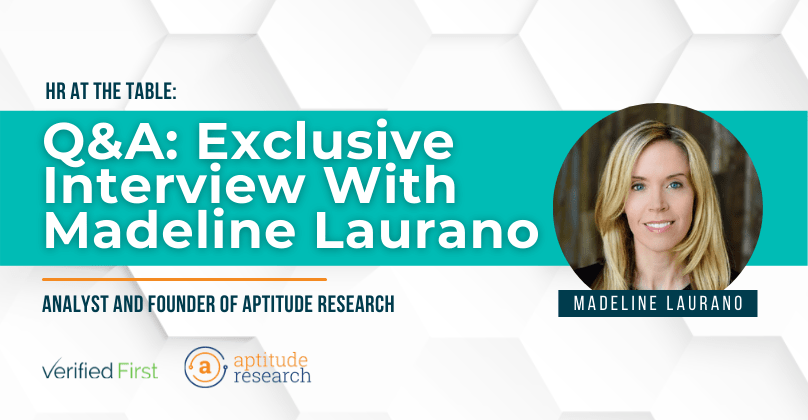
The last year and a half have been like no other. Life changed overnight, significantly transforming the workforce. One of the most significant impacts we have seen has been finding and retaining talent during a worldwide pandemic. To unwrap the current state of talent acquisition (TA), we met with industry-leading analyst and Founder of Aptitude Research, Madeline Laurano.
In an exclusive HR at the Table interview, Madeline Laurano addressed four vital questions around talent acquisition:
“For a lot of companies, they're still figuring out what technology can do to help them with their diversity goals within talent acquisition. If you’re not really sure what role technology plays with DE&I, become a champion for it.”
“We need to be able to engage with candidates before they apply so you’re able to build relationships and a stronger employer brand. Then, there's a whole ecosystem of communication, background screening, and assessments that really help fuel talent acquisition today. So for companies that have been laser-focused on the ATS, it's really proved to be not enough today.”
“Integrations are probably the most critical thing companies can think about when they're looking at their TA tech stack today. But, we found that one in two companies aren’t even thinking about integration before they start to evaluate providers. That’s when you ask: (1) What integrations are in place? (2) What does the integration look like? (3) Who owns the APIs? (4) Is there a Chrome extension? (5) What are these providers doing to help support you with those integrations?”
“For a period of time, we talked about time-to-fill as if it was negative. Efficiency is not as important as quality or effectiveness. That’s really flipped this last year. In the research report, you’ll see that efficiency is a key driver for technology decisions because companies had to adapt and adjust overnight [due to COVID-19]. Efficiency impacts recruiter productivity and the candidate experience as well. Not just through the employer lens, candidates want to move along quickly so they know what’s next, so they have a job.”
“Organizations in high-volumes like CVS, Wal-Mart, Amazon, McDonald’s, etc. are having to say, ‘we can’t hire in two weeks. We have to hire in two days. We need people in two days.’ We’re seeing this in every organization now. Every industry now has these incredible goals within talent acquisition that have just happened overnight. They need to be able to move quickly and efficiency has got to be a big part of that.”
“Businesses and candidates don’t really understand what recruiters do. They just focus on the priorities for the company and the priorities for the candidate experience. The recruiter role has been pretty neglected from conversations around talent acquisition. They are overwhelmed, feeling burnout, and working harder than they ever have before. We are just starting to see companies pay attention to this but they need solutions that are going to lift that administrative burden to help them do their job in a way that allows for a better work-life balance.”
“Forty-four percent of companies invested in new technology during the pandemic. Communicating, screening, assessing candidates, and AI matching hadn’t been topics organizations had been thinking about. Technology, bringing it together, has helped to accelerate their hiring process.”
“People are worried about safety. They’re worried about childcare. When candidates are in that situation, they ask where will I work and do I need to work? The fear or reality of going back into the office is something that’s a big part of the candidate’s decision.”
“Studies show that 2.2 million women were reported to have actually left the workforce. With them in mind, are there returnship programs that companies are thinking about? Are there more contract opportunities? Are there contingent workforce opportunities for women to be able to stay a part of the workforce?”
“As hiring slows down a bit and hiring practices change, we start to focus on our internal candidates. We’re going to see more roles like digital specialists, recruitment operations, and data scientists to be part of the TA function. Those could be the role of the recruiter building those capabilities through training and workshops or it could be dedicated roles that are brought into the TA function for that.”
“A lot of companies took a band-aid approach to remote work. What does the long-term plan for the future look like? What are the technology solutions that can support that?”
“Look at where your organization is. Are you ready for new technology? What’s working? What’s not working? What’s required when you invest in new technology? What types of change management will you experience?”
“It can be challenging to figure out what you need, what’s going to work, and what providers look at. But if you start to think about the market, you can start to figure out who the providers are and what would be valuable and important to your organization.”
“Figure out how to involve IT. What frustrations come up with integration? What isn’t going to work? What needs to work to make it happen? Don’t forget about ROI. Measure ROI early. Talk about ROI — even before you’ve made an investment.”
Overall, the talent acquisition space is rapidly changing. The role of the recruiter is adapting to new challenges that have arisen due to the pandemic. Facing burnout and rejection, companies need to start looking at long-term, technology-driven solutions to support their recruiters and talent acquisition strategy as a whole.
While this is just a brief overview of our discussion with Madeline Laurano, you can dive into the full interview on the State of Talent Acquisition Technology: 2021 Trends here. Also, enjoy this complimentary Talent Acquisition Technology Buyer’s Guide for a deeper look into Madeline Laurano and Aptitude Research’s latest findings!
For more valuable HR at the Table insight, register for our next discussion: Leadership Lessons HR Can Learn From a Marine Veteran.